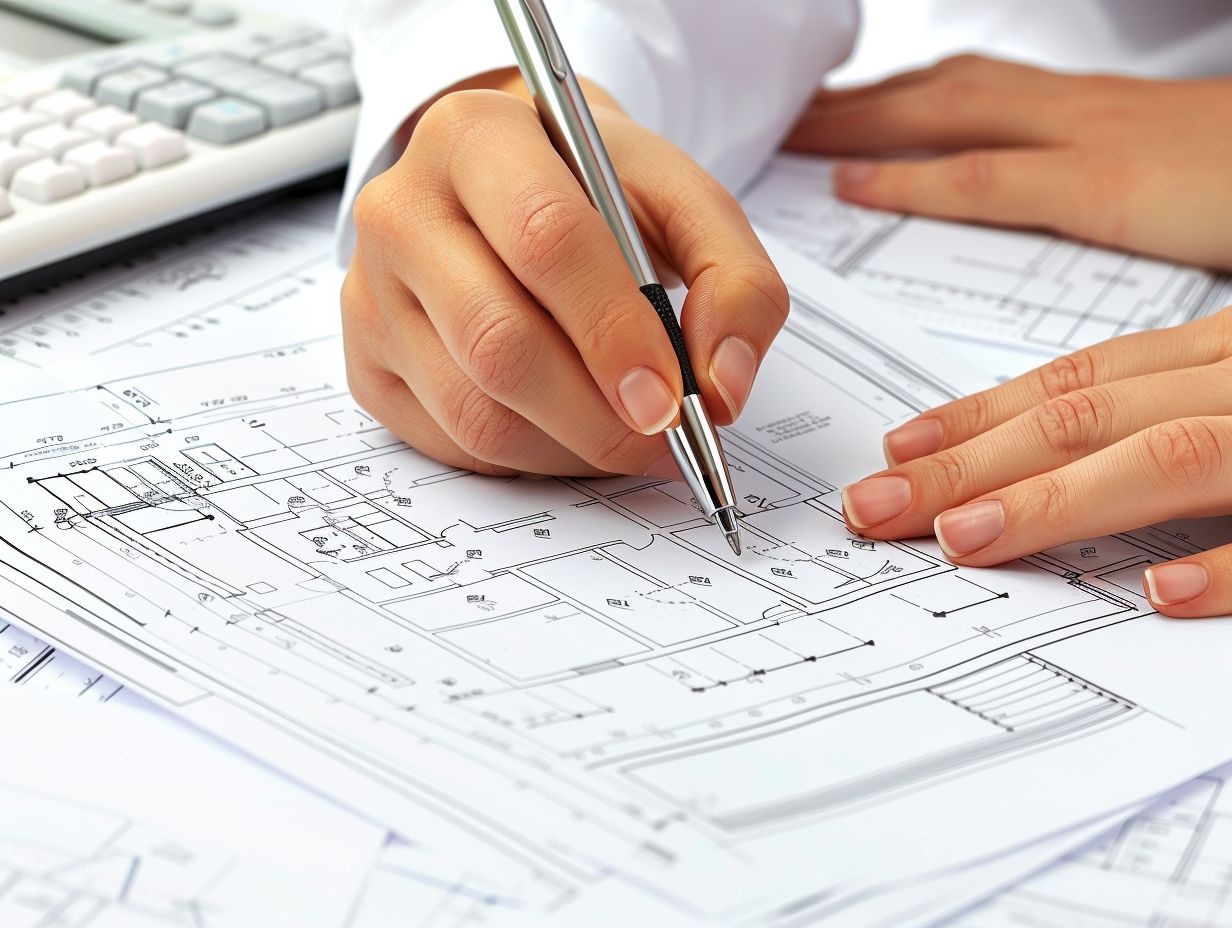
Inside SF’s Residential Structural Engineering: Safety Meets Style
Welcome to our comprehensive guide on residential structural engineering, where we delve deep into the vital aspects that ensure the safety and functionality of homes. In this article, we’ll explore the importance of residential structural engineering, its different types, safety measures, incorporation of style, and the step-by-step process involved.
Whether you’re a homeowner looking to understand the structural integrity of your property or a professional in the construction industry, this article aims to provide valuable insights into how residential structural engineering combines safety with style in San Francisco’s unique urban environment. So, let’s embark on this journey to uncover the fundamental principles and practices of residential structural engineering.
What Is Residential Structural Engineering?
Residential structural engineering involves the application of engineering principles to the design, construction, and seismic retrofitting of buildings and architectural elements in residential structures, ensuring earthquake-resistant and aesthetically pleasing building design.
It plays a critical role in ensuring that residential buildings can withstand seismic forces and provide a safe environment for occupants. This encompasses the use of earthquake-resistant design techniques, such as reinforced concrete and structural bracing, to mitigate potential damage. Residential structural engineers collaborate with architects to integrate aesthetic features seamlessly into the structural design, enhancing the overall visual appeal of the building. By balancing seismic resistance, architectural creativity, and functional integrity, residential structural engineering contributes to the creation of resilient and visually captivating residential spaces.
Why Is Residential Structural Engineering Important?
Residential structural engineering is crucial for ensuring the structural integrity and safety of residential buildings, incorporating innovative construction techniques and conducting thorough structural analysis to enhance seismic performance and building safety.
It plays a vital role in evaluating the structural elements of a building, such as foundations, walls, and roofs, to ensure they can withstand various external forces and environmental conditions. By employing advanced engineering principles and materials, residential structural engineers strive to design and construct buildings that can withstand seismic activity and adverse weather conditions. Their expertise in analyzing building materials and construction methods contributes to the overall safety and reliability of residential structures, providing peace of mind for homeowners and occupants.
What Are the Different Types of Residential Structural Engineering?
Residential structural engineering encompasses various specialized areas including foundation design, roof design, wall design, floor design, and structural inspections, each contributing to the overall seismic resistance and aesthetic appeal of building structures.
These components play crucial roles in ensuring that residential buildings are structurally sound and can withstand various environmental and geological factors. Foundation design involves determining the type of foundation suitable for the soil condition and the load-bearing capacity of the structure. Roof design focuses on selecting appropriate materials and configurations to provide protection from weather elements while enhancing energy efficiency.
Wall design considers factors such as load-bearing capabilities, insulation, and architectural aesthetics, while floor design incorporates elements of sustainability, durability, and functional design. Structural inspections are essential to assess the integrity of these elements and identify any potential weaknesses or areas for improvement.
Foundation Design
Foundation design in residential structural engineering involves a meticulous construction process, utilizing appropriate building materials and architectural design principles to ensure the stability and longevity of the building’s foundation.
The construction process for the foundation design encompasses a thorough assessment of soil composition, loading requirements, and environmental factors to determine the most suitable foundation type, such as shallow or deep foundations, raft foundations, or pile foundations. The choice of building materials, including concrete, steel, or wood, is crucial in effectively distributing the structural loads and withstanding environmental stresses.
Architectural design considerations, such as proper drainage, waterproofing, and slope management, play a pivotal role in enhancing the foundation’s stability and longevity.
Roof Design
Roof design in residential structural engineering involves the implementation of robust structural systems and adherence to engineering practices and building regulations to ensure the structural integrity and safety of the building’s roof.
This process requires thorough consideration of various factors such as load-bearing capacity, material selection, and dynamic forces, all of which contribute to the overall stability and longevity of the roof. Engineers must navigate through a myriad of building codes and regulations to ensure that the design meets all necessary safety standards.
The incorporation of sustainable and energy-efficient practices plays a crucial role in modern roof design, aligning with global trends towards environmental responsibility and energy conservation.
Wall Design
Wall design in residential structural engineering is tailored to withstand seismic activity, incorporating robust building standards and safety measures to ensure the structural resilience and safety of the building’s walls.
This entails the use of reinforced materials and construction techniques that can absorb and redistribute the forces exerted during seismic events, effectively minimizing potential damage. Building codes and regulations play a pivotal role in dictating the minimum requirements for wall design, ensuring that they are able to withstand seismic forces within acceptable margins.
The implementation of safety measures such as flexible connections and bracing further fortifies the walls, enhancing their ability to endure seismic loads and guarantee structural integrity.
Floor Design
Floor design in residential structural engineering incorporates innovative design elements and high-quality materials to optimize seismic performance and ensure the overall structural integrity and safety of the building’s floors.
This integration of design elements and materials is crucial for withstanding seismic forces. Incorporating technologies such as base isolation and damping systems, along with the use of high-strength concrete and steel reinforcements, can significantly enhance a floor’s ability to withstand earthquakes.
The strategic placement of load-bearing walls and columns, as well as the incorporation of flexible floor diaphragms, further contribute to the structural resilience of the building. These measures collectively elevate the seismic performance of the floor design, safeguarding the occupants and property during seismic events.
Structural Inspections
Structural inspections in residential structural engineering involve rigorous adherence to construction standards, implementation of advanced engineering techniques, and considerations for building aesthetics to evaluate and maintain the structural integrity and safety of residential buildings.
These inspections play a crucial role in identifying potential weaknesses or hazards that could compromise the stability of the structure. By utilizing engineering techniques such as load calculations, material testing, and structural analysis, engineers can ensure that the building meets the required safety standards.
Balancing building aesthetics with structural integrity is essential to create a safe and visually appealing living space for occupants. The integration of these elements ensures that residential structures are not only safe but also visually pleasing, adding value to the property and enhancing overall satisfaction for residents.
What Are the Safety Measures in Residential Structural Engineering?
Residential structural engineering incorporates essential safety measures such as earthquake-proofing, fireproofing, wind load resistance, and flood prevention, ensuring compliance with stringent building standards to safeguard the occupants and assets within residential buildings.
These safety measures are crucial components in protecting residential structures from natural disasters and adverse weather conditions. Engineering solutions such as reinforced foundations, flexible building materials, and strategic positioning of utilities can significantly enhance seismic resistance and mitigate earthquake-related risks. Advanced fire-rated materials, fire escape planning, and smoke detection systems are integrated to improve fire safety. Wind load resistance strategies include strategic building design, installation of impact-resistant windows, and secure roofing systems to minimize wind-related damage.
Flood prevention methods encompass elevation of structures, water-resistant building materials, and adequate drainage systems to reduce flood risks and protect inhabitants and assets.
Earthquake-proofing
Earthquake-proofing measures in residential structural engineering focus on enhancing seismic resistance while maintaining construction safety and preserving the building aesthetics to protect occupants and assets during seismic events.
This involves the use of seismic-resistant building materials such as reinforced concrete and steel, as well as innovative structural designs to dissipate seismic forces. Construction safety is ensured through rigorous adherence to building codes and regulations, including proper foundation anchoring and bracing. Architects collaborate to integrate earthquake-resistant features seamlessly into the building’s design, ensuring that the aesthetics are not compromised. The amalgamation of these efforts results in structures that not only withstand seismic events but also provide a visually appealing and safe environment for occupants and valuable assets.
Fireproofing
Fireproofing strategies in residential structural engineering involve the utilization of specialized building materials, innovative structural design, and engineering practices to mitigate fire hazards and enhance the overall fire safety of residential buildings.
These strategies include the use of fire-resistant materials such as intumescent coatings, fire-retardant-treated wood, and fire-resistant plaster. Innovative structural designs such as compartmentalization, flame-resistant barriers, and adequate spacing between buildings can help prevent the spread of fires. Engineering practices, such as incorporating automatic sprinkler systems, smoke detectors, and fire-resistant insulation, further contribute to creating a safer living environment in residential structures.
Wind Load Resistance
Wind load resistance in residential structural engineering encompasses the integration of architectural features, adherence to construction standards, and seismic design principles to bolster the structural resilience and stability of buildings against wind-induced forces.
Architectural features play a crucial role in mitigating wind loads, as different building designs can either enhance or impede wind flow, impacting the overall structural stability. Compliance with construction standards ensures that buildings are constructed with materials and methods that can withstand wind pressure and dynamic forces. Seismic design principles further contribute to the wind load resistance by considering the impact of earthquakes and other related movements on the building’s structural integrity.
Flood Prevention
Flood prevention strategies in residential structural engineering incorporate sustainable and innovative approaches, aligning with building codes to mitigate flood risks and protect residential properties against the detrimental effects of flooding.
These strategies include:
- elevating homes above flood levels
- installing flood barriers and flood-resistant materials
- implementing proper site grading to redirect water away from structures
Integrating green infrastructure such as permeable pavements and green roofs also plays a crucial role in managing stormwater and reducing flood impact.
Adhering to building codes that address flood hazard areas and promoting resilient design further strengthens the overall flood prevention efforts, ensuring that residential properties are better equipped to withstand and recover from potential flood events.
How Does Residential Structural Engineering Incorporate Style?
Residential structural engineering incorporates style through open floor plans, the use of sustainable materials, incorporation of natural light, and creative use of structural elements as design features, enhancing the aesthetic appeal and functionality of residential buildings.
This approach emphasizes the seamless integration of architectural design with structural elements, creating spaces that feel expansive and connected. Sustainability is a key focus, with the incorporation of eco-friendly materials and energy-efficient systems that embrace the principles of green building. The strategic placement of windows and skylights maximizes natural light, fostering a sense of brightness and openness. Innovative use of structural elements as architectural features adds a unique touch to the overall design, elevating the visual and spatial experience of residential spaces.
Open Floor Plans
Open floor plans in residential structural engineering are designed to align with building standards, incorporate diverse architectural styles, and utilize structural elements to create spacious and visually appealing living spaces within residential buildings.
The integration of open floor plans with building standards ensures that safety and functionality are prioritized in the design process. Architects and engineers are increasingly incorporating various architectural styles, such as modern, minimalist, or industrial, to cater to diverse aesthetic preferences.
The strategic use of structural elements like columns, beams, and materials like glass and steel helps in creating an open and airy environment while maintaining structural integrity.
Use of Sustainable Materials
The use of sustainable materials in residential structural engineering involves a meticulous construction process to integrate eco-friendly materials, ensuring structural safety and contributing to the overall sustainability and environmental impact of residential buildings.
Utilizing sustainable materials, such as reclaimed wood, recycled steel, and energy-efficient insulation, is an effective approach for minimizing the environmental footprint of residential construction. These materials not only reduce the depletion of natural resources but also offer durability and strength, thus enhancing the structural integrity of the buildings.
The integration of sustainable materials requires thorough planning and execution to ensure that the construction process aligns with eco-friendly practices, ultimately leading to buildings that are safer, more energy-efficient, and environmentally sustainable.
Incorporation of Natural Light
The incorporation of natural light in residential structural engineering focuses on integrating architectural features and design elements to optimize natural lighting, enhancing the building aesthetics and creating a visually appealing and sustainable living environment.
This approach not only adds to the visual appeal of the interiors but also contributes to the energy efficiency of the building. Architects often utilize elements such as skylights, large windows, and open floor plans to maximize the penetration of natural light, creating a warm and inviting ambiance.
The strategic placement of reflective surfaces and light wells further amplifies the effect of natural light, bringing in a sense of spaciousness and airiness to the living spaces.
Creative Use of Structural Elements as Design Features
The creative use of structural elements as design features in residential structural engineering integrates diverse architectural styles and engineering practices to transform structural components into visually impactful and aesthetically pleasing design elements within residential buildings.
It is fascinating to see how the incorporation of elements such as steel beams, exposed trusses, and cantilevered structures seamlessly merges with architectural styles like modernist, minimalist, or even traditional aesthetics to create striking visual appeal. The engineering precision behind these elements not only ensures the structural integrity of the building but also adds a sense of artistry and sophistication to the overall design. This integration not only enhances the structural stability but also elevates the building’s aesthetic appeal, portraying a perfect harmony between form and function.
What Are the Steps Involved in Residential Structural Engineering?
Residential structural engineering encompasses essential steps such as:
- Site investigation and analysis
- Design and planning
- Structural calculations
- Construction and inspection
These steps align with seismic activity considerations and innovative engineering techniques to ensure the structural integrity and safety of residential buildings.
Site investigation involves evaluating the geological and geological conditions of the area, as well as assessing the potential seismic risks.
Design and planning encompass developing detailed structural drawings and plans, considering factors such as load-bearing capacity and earthquake-resistant design.
Structural calculations focus on determining the appropriate materials and dimensions for the building’s components, while construction and inspection ensure that the construction adheres to the design specifications, codes, and standards, employing innovative engineering techniques for enhanced safety and resilience.
Site Investigation and Analysis
Site investigation and analysis in residential structural engineering involve meticulous adherence to construction codes and regulations, focusing on assessing seismic performance and understanding site-specific factors to inform the subsequent design and construction processes.
This thorough examination encompasses a detailed review of local building codes to ensure that the construction plans comply with the appropriate standards and regulations. Engineers carefully evaluate the seismic performance of the site, considering factors such as soil composition, topography, and historical seismic activity. By integrating these site-specific considerations into the design process, engineers can mitigate potential risks and create structures that are better equipped to withstand seismic events, ultimately enhancing the safety and resilience of residential buildings.
Design and Planning
Design and planning in residential structural engineering revolve around meticulous structural design, incorporation of architectural elements, and adherence to construction standards to ensure the seamless integration of safety, functionality, and aesthetic appeal within the residential building design.
Structural design plays a pivotal role in determining the overall stability and load-bearing capacity of a residential structure. This involves strategic placement of beams, columns, and foundational systems to withstand varying environmental conditions and potential stress factors. Architects focus on incorporating unique architectural elements such as facades, roof designs, and interior spaces to infuse individuality and character into the residential buildings.
Compliance with construction standards ensures that the construction processes align with legal and safety requirements, contributing to the creation of resilient and enduring residential structures.
Structural Calculations
Structural calculations in residential structural engineering are rooted in engineering principles, focusing on optimizing seismic resistance and integrating design elements to guarantee the structural integrity and safety of residential buildings.
These calculations are fundamental in determining the size and placement of load-bearing elements, such as beams and columns, ensuring that they can support the imposed loads effectively. Seismic resistance considerations involve evaluating the building’s response to seismic forces by incorporating measures like bracing and foundation design to enhance its stability during earthquakes.
The integration of design elements, such as architectural features and functional spaces, is essential for creating aesthetically pleasing and functional residential structures that meet both safety and aesthetic requirements.
Construction and Inspection
The construction and inspection phase in residential structural engineering prioritizes the seamless integration of building aesthetics, structural safety, and architectural design elements, ensuring the successful implementation and assessment of the engineered structural plans.
This phase involves meticulous attention to detail, encompassing not only the functionality of the structure but also its visual appeal and adherence to architectural specifications. Engineers and inspectors collaborate to ensure that the design elements are not compromised for the sake of structural integrity and safety. From choosing materials that offer both durability and aesthetic value to verifying that the final construction aligns with the original design, every aspect is carefully considered. This comprehensive approach ultimately results in buildings that are both visually striking and structurally sound.




No Comments